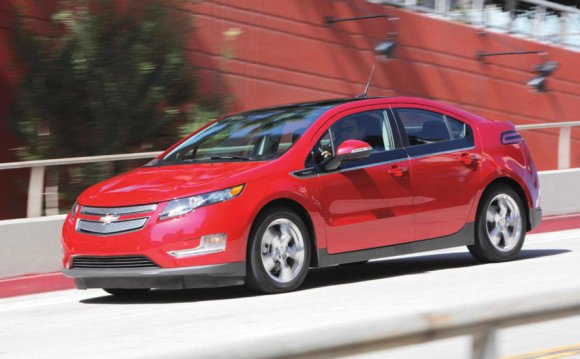
While the car grows, its weight shrinks, our loaded Premier tester tallying 3396 pounds against 3766 for our last Volt test car. That triumph means the Volt effectively eliminates the mass gap with its arch rival, the Toyota Prius plug-in, and greatly narrows it against the regular Prius. Much of the Volt’s excess cottage cheese came off the electric drive unit (99 pounds) and battery pack (31 pounds), which is where the most-profound changes to Volt II are found.
GM’s marching orders from its customers were clear: Give us more range in EV mode, make the engine quieter, and give the car more driving spunk. The old powertrain, which paired an iron-block 1.4-liter four-cylinder to one large propulsion/regen motor/generator and one smaller multipurpose electric machine, got a complete rethink. Now, a more powerful Atkinson-cycle 1.5-liter aluminum-block engine works in concert with two smaller motor/generators, housed inside a transaxle to drive the differential through a chain rather than gears as before.
Engineers studied a range of engines, from a 1.0-liter turbo three-cylinder to the 1.5, and selected the largest because of a fact that Corvette owners have long known: A bigger engine turning more slowly can be remarkably efficient. And quiet. And quicker, if need be, since the bigger engine doesn’t need to call on the motors as much when the driver floors it. The long, 86.6- millimeter (3.41-inch) stroke makes the Volt’s lump a sort of automotive tugboat engine, a low-speed torque machine with its 101 horsepower arriving at just 5600 rpm.
|
The new Volt has an interior that looks like a car interior (and a nice one) instead of a soon-to-be laughably outdated gadget. |
As promised, the Volt is quiet even with the plugs firing, unless you really draw the battery down by, say, running nine successive quarter-miles, or by climbing a mountain. When it needs to run hard, the 1.5 buzzes with labored effort, a noise especially apparent when you come to a red light. Most engines are at their quietest then, but the Volt’s can be cranking away in a frenzy, charging the battery. It’s one of the peculiar idiosyncrasies of this powertrain, but GM claims that the Volt II falls into these charging holes less often than Volt I, so it’s a rarer occasion. At its highest speeds, the engine vibrations in our early test car found something sympathetic in the body to rattle, producing a clattery duet.
You can tell that GM closely studied the way EV drivers operate their vehicles. It’s all about energy management, and Volt II gives you lots of control. For example, the four driving modes include normal, sport, and mountain, which cuts the EV-only range to preserve the battery for expected long climbs, plus hold, which lets you save the battery for whenever you want EV miles. Those modes carry over from the gen-one Volt, but even handier is a new regen paddle on the back of the steering wheel, which turns a clunky hypermiling technique done with the shifter in many EVs into a simple fingertip function. Most EVs offer some kind of max-regen mode, but you usually have to shift into low or “B” to engage it, then shift back to D for normal acceleration. The Volt makes it much easier. The paddle only works when you lift off the gas, engaging maximum regeneration. In many daily situations, the paddle cuts the car’s speed enough to provide all the deceleration you need and it will even stop the car completely. Which means the friction brakes, those energy-squandering devices from the smokestack era, can be used less often in favor of the paddle, which pours electrons back into the battery.
INTERESTING VIDEO












